The pickups in your bass are the magnetic heart of the instrument. Out of all the characteristics of your bass, they have the most significant influence on your tone. And because of their relatively low cost when compared to the price tag of a new instrument, many bass players choose to first upgrade their pickups before going for that shiny new bass in search of the perfect tone.
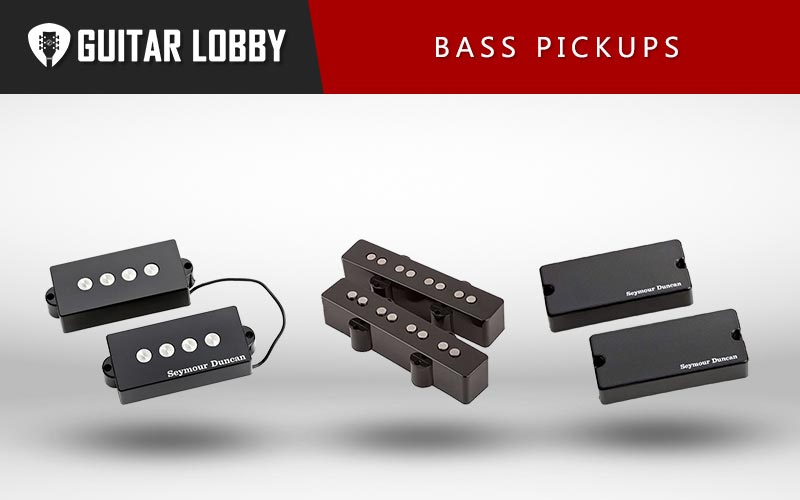
The only problem is there are a lot of pickups out there, and it can get very confusing when trying to pick the right ones. If you are thinking about upgrading your trusted bass, read on, because in the next section we’ll discuss the best bass pickups at each price point. If you want to learn more about bass guitar pickups before going through the reviews, take a look at the buying guide at the bottom of the page.
The pickups on this list will focus on 4-string basses as they represent the vast majority of bass guitars out there, but most of these pickups are also available in at least 5 string configurations.
| Name of Product | Image of Product | Description | Price Range | Full Review |
|---|---|---|---|---|
| 1. Seymour Duncan SPB-3 Quarter Pound P-Bass Pickup (Best Value) | 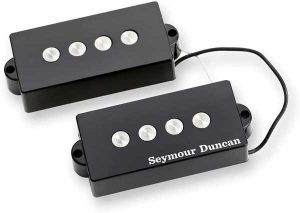 | Type: Passive Split-coil P-Bass pickup Magnet Type: Alnico 5 rod magnets with exposed pole-pieces | $75 | Read Full Review Below |
| 2. DiMarzio DP 122 Model P (Best Cheap) | 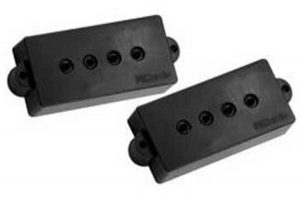 | Type: Passive Split-coil P-Bass pickup Magnet Type: Ceramic | $70 | Read Full Review Below |
| 3. DiMarzio DP127 Split P Pickup (Editors Choice) | 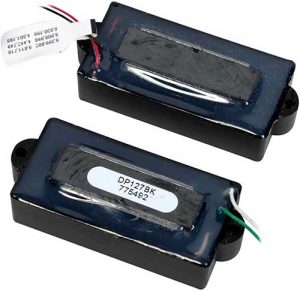 | Type: Passive P-style Split Humbucker Magnet Type: Ceramic | $85 | Read Full Review Below |
| 4. Aguilar 4P-60 P-Bass Pickup (Best Overall) | 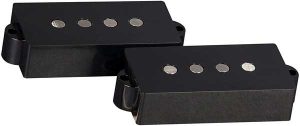 | Type: Passive Split-coil P-Bass pickup Magnet Type: Alnico 5 | $120 | Read Full Review Below |
| 5. Fender Custom Shop ‘62 Precision Bass Pickup | 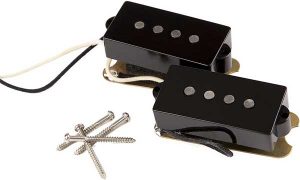 | Type: Passive Split-coil P-Bass pickup Magnet Type: Alnico 5 | $130 | Read Full Review Below |
| 6. Seymour Duncan SPB-4 Steve Harris Signature P-bass Pickup | 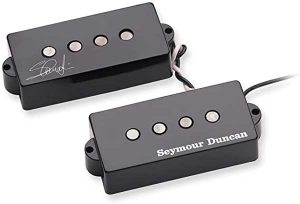 | Type: Passive split-coil P-bass pickup Magnet Type: Alnico 5 | $90 | Read Full Review Below |
| 7. Seymour Duncan SJB-3 Quarter Pound Jazz Bass set (Best Value) | 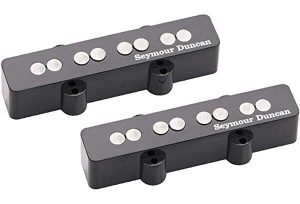 | Type: Passive Single-coil J-Bass pickup Magnet Type: Alnico 5 | $130 | Read Full Review Below |
| 8. DiMarzio DP149 Ultra Jazz Bass set (Best Cheap) | 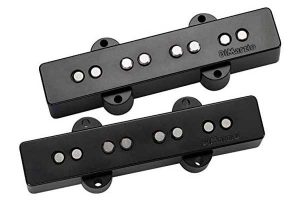 | Type: Passive hum-canceling J-Bass pickups Magnet Type: Alnico 5 and Ceramic | $120 | Read Full Review Below |
| 9. Aguilar AG 4J-60 Jazz Bass Pickup set (Best overall) | 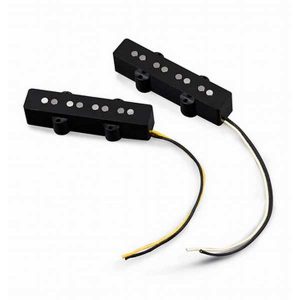 | Type: Passive Single-coil J-Bass pickups Magnet Type: Alnico 5 | $160 | Read Full Review Below |
| 10. Fender Custom Shop ‘60 Jazz Bass Pickup set (Editors Choice) | 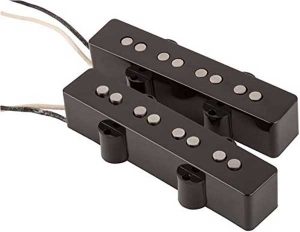 | Type: Passive Single-coil J-Bass pickups Magnet Type: Alnico 5 | $160 | Read Full Review Below |
| 11. DiMarzio DP123 Model J Jazz Bass Pickup set | 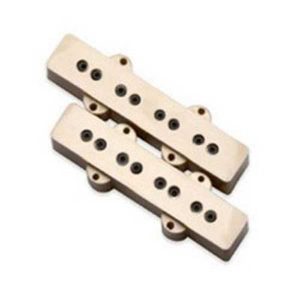 | Type: Passive hum-canceling split single-coil J-Bass pickups Magnet Type: Ceramic | $130 | Read Full Review Below |
| 12. Lindy Fralin Jazz Bass Pickup set | 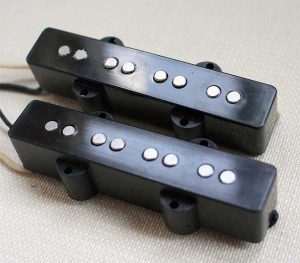 | Type: Passive Single-coil J-Bass pickup set Magnet Type: Alnico 5 | $190 | Read Full Review Below |
| 13. Seymour Duncan SMB-4A MM Pickup | 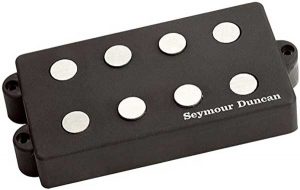 | Type: Passive 3-coil MM-style humbucker pickup Magnet Type: Alnico 5 | $100 | Read Full Review Below |
| 14. Dimarzio DP120 Model One | 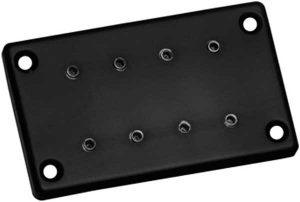 | Type: Passive Humbucking pickup Magnet Type: Ceramic | $125 | Read Full Review Below |
| 15. Seymour Duncan ASB-BO Blackout set | 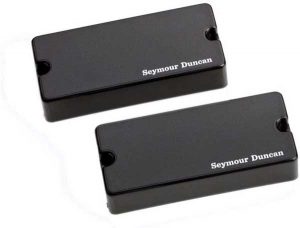 | Type: Active Humbucking Soapbar pickup set Magnet Type: Ceramic | $220 | Read Full Review Below |
| 16. EMG DE David Ellefson Signature Pickup set | 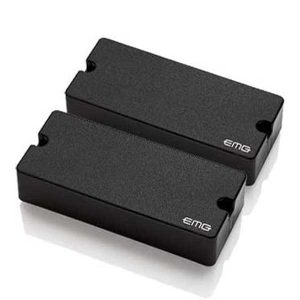 | Type: Active Humbucker Soapbar pickups Magnet Type: Dual-coil humbucker(Bridge), Ceramic/Steel(neck) | $200 | Read Full Review Below |
| 17. EMG 35 HZ pickup | 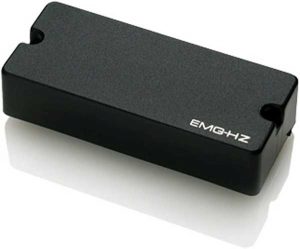 | Type: Passive Dual-coil humbucking pickup Magnet Type: Ceramic/steel bar magnets | $100 | Read Full Review Below |
Here Are the Best Bass Pickups (All Types)
1. Seymour Duncan SPB-3 Quarter Pound P-Bass Pickup (Best Value)
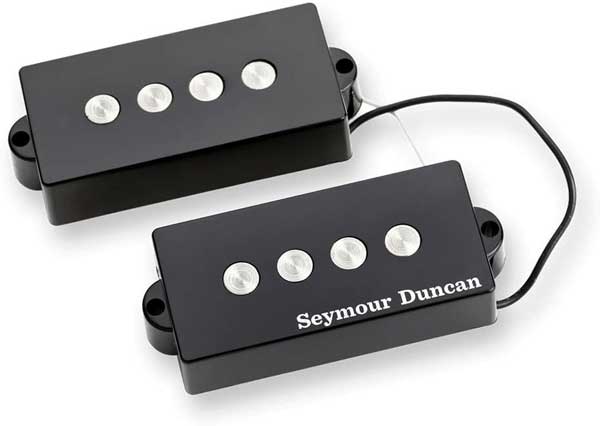
| Estimated Price | $75 |
| Type | Passive Split-coil P-Bass pickup |
| Magnet Type | Alnico 5 rod magnets with exposed pole-pieces |
| Number of Strings | 4 (also available in a 5 string configuration)++ |
| Pickup Covers | Black |
My Review: The SPB-3 Quarter Pound was designed as a modern high-quality drop-in replacement for the Fender Precision Bass guitar. It has a fat and punchy tone with heaps of low-end, a well-defined mid-range, and its treble response is much improved over original Fender P-style pickups. This is a very hot pickup so cutting through the mix will be a piece of cake, be it on stage or in the studio. It offers a more modern take on the classic Precision bass sound and would feel at home in any genre of music due to its extended frequency range.
Key Specs: Among the first things you will notice when laying eyes on the SPB-3 are the oversized quarter-inch Alnico 5 magnets responsible for its high output and wide frequency range. It comes only with black pickup covers. There are no pickup height foam inlays in the box so you’ll either salvage the ones from the pickups you are replacing or you remember to buy some new ones. The SPB-3 Quarter Pound pickups are hand-built in Santa Barbara, CA.
Target Customer: This pickup is aimed at the modern Precision Bass player in search of a modern take on the classic precision sound. Fans of the vintage precision sound would find this pickup too ”full range” sounding and would probably enjoy a more “classic”, lower output pickup.
Bottom Line: This is a pickup for those who want a high quality, high output pickup for a modern Precision Bass tone that won’t break the bank. In my opinion, this is easily one of the best P bass pickups for the money.
2. DiMarzio DP 122 Model P (Best Cheap)
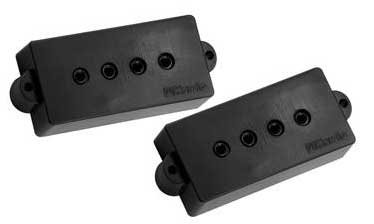
| Estimated Price | $70 |
| Type | Passive Split-coil P-Bass pickup |
| Magnet Type | Ceramic |
| Number of Strings | 4 |
| Pickup Covers | Black or Cream |
My Review: The DiMarzio DP122 Model P has been a staple replacement pickup for Precision-style basses since 1977 and it won’t go away anytime soon, in part due to its huge tone and attitude at a very affordable price point. The powerful ceramic magnet sits at the heart of this high output pickup and feels at home in any style of music but will be more inclined towards the heavier end of the spectrum, ideally rock metal or punk.
The hum-canceling design of the Model P aims to make your tone clear and punchy without sacrificing any of your precious low-end while providing plenty of mid-range growl to cut through any mix. This pickup delivers a high-gain bass sound that has its focus on the low-end and midrange rather than the treble and will retain its clarity even while you’re heavily digging into your strings.
Key Specs: The DiMarzio Model P features powerful ceramic magnets for a high-gain tone with lots of low-end definition and mid-range growl. You have the option to choose between black or cream-colored pickup covers and three color options for the pole-pieces: black, gold, and nickel. There is no 5 string option for the Model P.
Target Customer: The DP 122 Model P is aimed at the owner of a Precision-style instrument looking to upgrade their bass of choice for a more aggressive style of music on a budget. But this is one of the rare cases where you will get much more than you pay for.
Bottom Line: This is a high quality, high output pickup, well suited for any kind of music genre, and it comes with a very affordable price tag.
3. DiMarzio DP127 Split P Pickup (Editors Choice)
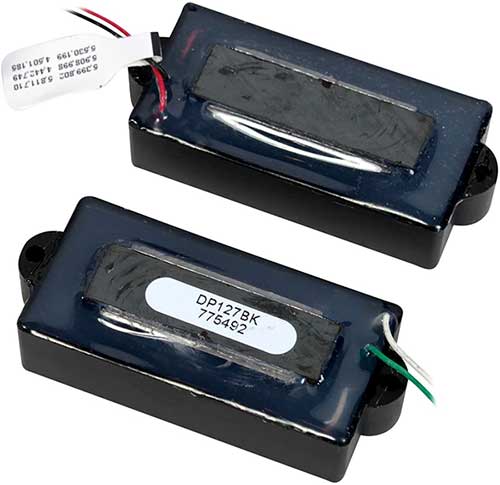
| Estimated Price | $85 |
| Type | Passive P-style Split Humbucker |
| Magnet Type | Ceramic |
| Number of Strings | 4 |
| Pickup Covers | Black or White |
My Review: The DiMarzio DP 127 Split P is somewhat of an oddball among replacement pickups for precision-style basses. With standard P-style pickups, each half of the pickup is a single-coil but as they are wired together and out of phase, they effectively make a split humbucking pickup. The DP 127, however, takes this concept one step further: each half of the pickup is a true humbucker (with two coils per half). As a result, this is a very hot and very responsive pickup, EQ’d to expand the frequency range of your bass by extending both the low-end and high-end response. The double-bladed design makes string spacing a non-issue while being very sensitive to both fingerstyle and pick-playing. Sonically, the DP127 has a solid low-end with a very smooth although slightly subdued mid-range and more treble than you would expect, from a P-style pickup. All in all, a very Hi-Fi sounding P-bass pickup with a snappy attack and an emphasis on tonal and dynamic versatility, well suited for any genre of music.
Key Specs: The DP127 is the “hottest” pickup in DiMarzio’s lineup with the highest output voltage. It is a true split humbucking pickup with powerful ceramic magnets at its core. The double-bladed rail construction makes for a sensitive and responsive pickup. You can choose between white and black pickup enclosures.
Target Customer: This pickup is a welcome addition to any Precision-type bass guitar, extending its typical frequency response at both the bass and treble side of the spectrum. The DP127 is a great performer in any situation, better suited for players looking for modern sounds.
Bottom Line: A great pickup with great sound, adding an unusual amount of versatility to any bass with the right cutout. At this price, you’ll be hard-pressed to find anything as good.
Popular Related Article: The 17 Best Bass Amps (All Price Ranges)
4. Aguilar 4P-60 P-Bass Pickup (Best Overall)
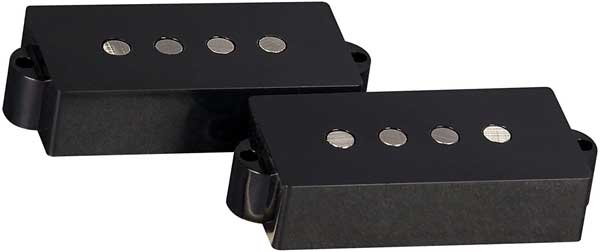
| Estimated Price | $120 |
| Type | Passive Split-coil P-Bass pickup |
| Magnet Type | Alnico 5 |
| Number of Strings | 4 (also available in 5 and 6 string configurations) |
| Pickup Covers | Black |
My Review: The 4P-60 Precision-style bass pickups are the result of trying to reproduce the pickups found in the 60s Precision basses owned by Aguilar president Dave Boonshoft. And they’ve succeeded in their endeavor. These pickups use period-correct parts and wiring (or as correct as is possible today) including Alnico 5 magnets with exposed pole-pieces and Heavy Formvar wire to produce that 60s Precision Bass thump that instruments from that era are known and loved for, no matter what amp you plug them into. The 4P-60 pickups are specially wound so that they produce a warm, full-range tone with a fat and full low-end and punchy mid-range while retaining a harmonically rich high end. There is nothing out there that sounds quite like a pair of Aguilar’s 4P-60s.
Key Specs: The 4p-60 Precision-style pickups feature 60s era specifications, from the Alnico 5 magnets used at their core, to the type of wire used for the bobbin and the cloth-sleeved conductors. The pickup covers only come in black. Aguilar also offers a “hot” version of the 4P-60 with bigger magnets and overwound coils for a more aggressive tone, without any loss of dynamic range.
Target Customer: The 4P-60 P-style pickup is aimed at the player who cherishes the vibe and feel of a vintage Precision Bass. These pickups will transform your bass into a 60s era funk-machine.
Bottom Line: If the P-style pickup on your bass sounds too modern to your ears, this could be the pickup of your dreams. The 4P-60s packs just enough mid-range punch to cut through any mix and at $120, they are honestly priced compared to some of their competitors offering “vintage” pickup replicas. All things considered, these are easily some of the best bass pickups out there right now.
5. Fender Custom Shop P Bass Pickup
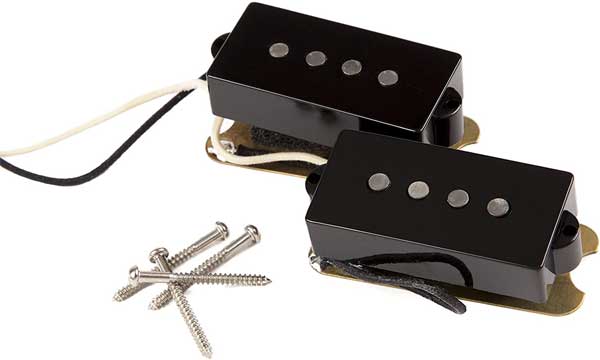
| Estimated Price | $130 |
| Type | Passive Split-coil P-Bass pickup |
| Magnet Type | Alnico 5 |
| Number of Strings | 4 |
| Pickup Covers | Black |
My Review: If you are looking for the most authentic vintage Fender Precision Bass sound there is, then look no further than the Custom Shop ‘62 Precision Bass Pickups. In classic P-bass fashion, it is a split-coil humbucking pickup with a vintage vibe to it. This is a higher-end pickup featuring flush-mounted Alnico 5 magnets and enamel-coated wire is used for the coils. This coated bobbin wire degrades the electrical signal to emulate the sound of a vintage pickup, resulting in a natural grit to the tone that almost sounds overdriven when you turn up the volume knob and really dig into the strings. The pickups have a balanced tone to them, with a fat and tight low-end, strongly accented, punchy mids, and clear, bright highs. The frequencies are balanced just right so you can fit in with any style of music and cut right through the mix. One of its greatest assets is its dynamic range and responsiveness, capable of smooth Motown-Esque thumping sounds as well as hard rock or metal driven bass lines without ever losing its footing.
Key Specs: The Custom Shop ‘62 Precision Bass pickup is Fender’s way of recreating the sound of a vintage pickup using new technologies. Its Alnico 5 magnets with flush-mounted, exposed pole pieces, the enamel-coated wire, the cloth sleeved conductors, all contribute to accurately imitate the tone of a vintage pickup.
Target Customer: If you own a bass that this pickup would fit into, and you like the sound of a vintage P-bass, this could be the most affordable way to achieve that iconic sound.
Bottom Line: The Custom shop ‘62 is one of the best P-bass pickups on the market. It’s not cheap by any standards but it is definitely worth every penny.
Popular Related Article: The 30 Best Bass Pedals (All Price Ranges)
6. Seymour Duncan SPB-4 Steve Harris Signature P-bass Pickup
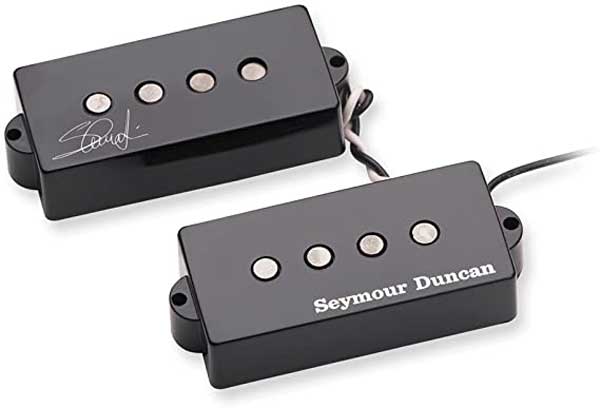
| Estimated Price | $90 |
| Type | Passive split-coil P-bass pickup |
| Magnet Type | Alnico 5 |
| Number of Strings | 4 |
| Pickup Covers | Black |
My Review: The SPB-4 is the result of a collaboration between Seymour Duncan and metal bass legend Steve Harris. The pickup is tailored to his two-finger playing style, but his needs seem to mirror the needs of rock and metal bass players in general. The SPB-4 is a medium output pickup, it uses Alnico 5 rod-magnets with exposed pole-pieces and a unique vintage hot-coil wind that delivers powerful sound with fast attack, a tight low-end, a low-mid boost, and slightly more high-end than you’ll usually hear on P-basses. The SPB-4 pickup is very responsive and has such a wide dynamic range that it will drive your preamp section harder than most other pickups out there without clipping it. Whether you play with your fingers or with a pick, this pickup’s metal pedigree will let you cut through the most crowded mix of distorted guitars.
Key Specs: The SPB-4 Steve Harris signature pickup features hand-ground Alnico 5 rod-magnets with exposed pole-pieces, and a special vintage-hot custom wind developed by Seymour Duncan, resulting in a boosted, aggressive midrange bite. The SPB-4 is handcrafted in Santa Barbara, CA, and is housed in a black enclosure adorned with Steve Haris’ signature on the top.
Target Customer: The SPB-4 will be a welcome addition to any metal, punk, or rock bass players’ Precision Bass or a clone thereof. It is a great pickup for beginners and more advanced players alike, offering a wide dynamic range tailored to heavier styles of music.
Bottom Line: This pickup brings a lot of low-end and mid-range growl to the table, it has a unique sound and may not be everyone’s cup of tea, but for all you metal bass players out there, it could be the only pickup you’ll ever want.
7. Seymour Duncan SJB-3 Quarter Pound Jazz Bass Set (Best Value)
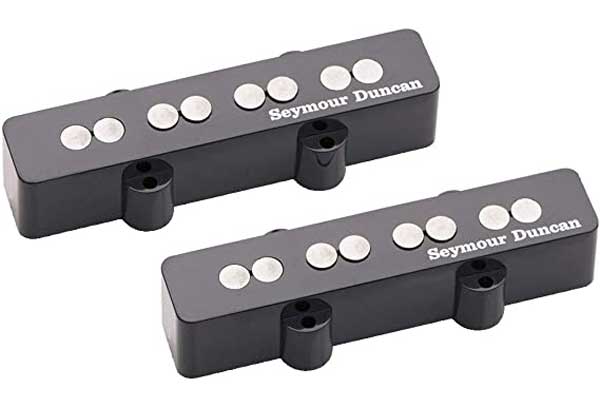
| Estimated Price | $130 |
| Type | Passive Single-coil J-Bass pickup |
| Magnet Type | Alnico 5 |
| Number of Strings | 4 (also available in 5 string configuration) |
| Pickup Covers | Black J-Style Pickups |
My Review: The SJB-3 Quarter Pound is an ideal way to give your bass more power and attack. Its oversized Alnico 5 magnets and the overwound coils make it best suited for a more aggressive play style and genre of music, but you still get the articulation and detailed high end of a vintage pickup. If you are looking for a reproduction of the original J-Bass sound, better look elsewhere, but if you are in the market for a powerful and dynamic pickup with a tight low end and very punchy midrange, you won’t be disappointed. The neck pickup is wound RWRP (reverse wound/reverse polarity), this means that when paired with the bridge pickup you will get hum cancellation. This set is a drop-in replacement for any American Standard Jazz Bass (not the Mexican-made ones) because the neck pickup is slightly shorter to accommodate the decreasing string spacing.
Key Specs: The SJB-3 Jazz Bass is a fairly hot output pickup set. They use quarter-inch Alnico 5 rod magnets with exposed pole-pieces and are overwound for extra gain and volume. The neck pickup is reverse wound and with reversed polarity for hum cancellation when used with the bridge pickup. This pickup set is hand-built in Santa Barbara, CA comes with black pickup covers, and is also available for 5 string basses.
Target Customer: These pickups are aimed at the bass player who appreciates the sound of a high gain, high volume sound. They are designed to give the Jazz Bass player a new set of tonal options.
Bottom Line: If you are looking for a traditional sound and feel, then maybe the SJB-3 set is not for you, but if you play rock or metal, these pickups are hard to beat and are some of the best bass guitar pickups on the market.
Related Article: 26 Easy Bass Guitar Songs for Beginners
8. DiMarzio DP149 Ultra Jazz Bass Set (Best Cheap)
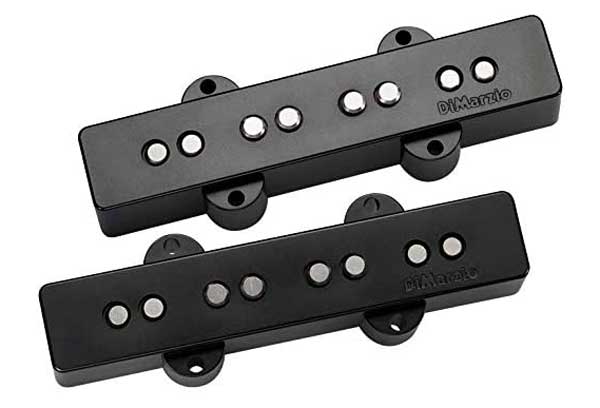
| Estimated Price | $120 |
| Type | Passive hum-canceling J-Bass pickups |
| Magnet Type | Alnico 5 and Ceramic |
| Number of Strings | 4 |
| Pickup Covers | Black or Cream |
My Review: The Dimarzio DP 129 Ultra Jazz Bass set is a great option if you want to upgrade the pickups in your stock Jazz Bass or any of its clones out there. The set consists of a matched pair of hum-canceling J-style bass pickups. The thing you will notice when comparing them to stock Jazz Bass pickups is the output, they are so much louder and are very responsive to your playing. From a tonal standpoint, they retain the vintage feel of the instrument while adding warmth and definition to your low-end. The midrange has a good presence to it while cutting nicely through the mix, and the highs are well defined and harmonically rich. Even with a relatively high output, the DP 129 set doesn’t lose any of its high-end.
Key Specs: The DP 129 Ultra Jazz Bass pickup is a high output, hum-canceling drop-in replacement for J-style basses. It’s fitted with a combination of Alnico 5 and ceramic magnets to eliminate the usual hum that standard single-coils are known for. With this design, hum-canceling is not achieved by stacking the coils, but by having each coil sensing a pair of your strings.
Target Customer: Anyone looking to replace the stock pickups in their Jazz Bass will not be disappointed with this set. The tonal and dynamic range will accommodate any playing style and genre of music.
Bottom Line: This is probably the most affordable way to dramatically improve the sound of your J-style bass. If you want to get rid of that pesky single-coil hum and get access to a wider range of sounds from your bass, give them a try. You can’t go wrong with the Dp149 Ultra Jazz Bass set.
9. Aguilar AG 4J-60 Jazz Bass Pickup Set (Best overall)
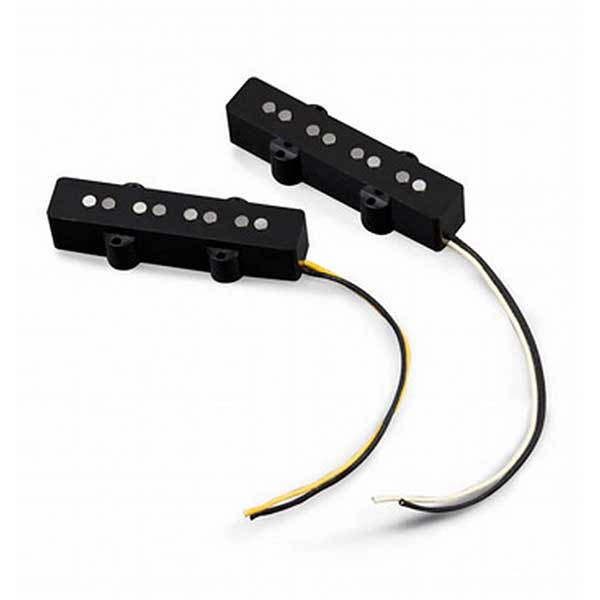
| Estimated Price | $160 |
| Type | Passive Single-coil J-Bass pickups |
| Magnet Type | Alnico 5 |
| Number of Strings | 4 (also available for 5 string basses) |
| Pickup Covers | Black |
My Review: The Aguilar 4J-60 set is modeled after vintage 60s era Jazz Bass pickups. They are built using period-correct parts like Alnico 5 rod magnets with exposed pole-pieces and heavy Formvar wire for the coils, to give you the feel and warm sounds of a vintage pickup. Aguilar uses a proprietary winding pattern for the coils to give each pickup a good balance between strings while giving you access to a wide range of punchy and articulate sounds. The overall tone is smooth and round, with a warm, well defined low-end, while mids are percussive and punchy. The high end is harmonically rich without sounding tinny. They have enough clarity and definition to reproduce the subtlest nuances of your playing.
Key Specs: The 4j-60’s are built with period-correct Alnico 5 rod magnets, heavy Formvar 42 gauge coil wire, and cloth-sleeved conductors to closely emulate the sound of a vintage 60s era pickup. They are specially wired to improve string-to-string consistency. They come in black pickup enclosures. The neck pickup is slightly shorter than the bridge pickup as is usual for Standard American Jazz Basses.
Target Customer: These pickups are ideal if you want to replace those stock pickups in your J-style bass and give your tone that vintage, warm sound.
Bottom Line: The Aguilar 4J-60’s will turn your J-style bass into an authentic 60s thumping beast, with all the definition and percussive character you could wish for.
Related Article: Recommended Bass Guitars for Beginners
10. Fender Custom Shop ‘60 Jazz Bass Pickup Set (Editors Choice)
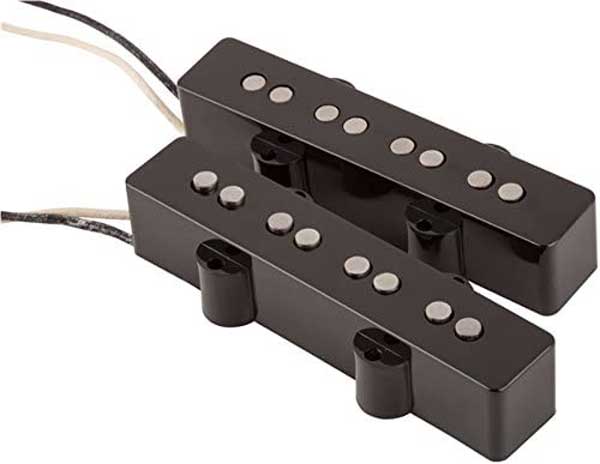
| Estimated Price | $160 |
| Type | Passive Single-coil J-Bass pickups |
| Magnet Type | Alnico 5 |
| Number of Strings | 4 |
| Pickup Covers | Black |
My Review: The Fender Custom Shop ‘60s are modeled after their original ‘60s era pickups, but these are slightly overwound, for greater output and growl. The vintage sound is still there for you to tap into, but they offer more versatility than the vintage pickup they are based on. The Custom Shop ‘60s are built using period-correct parts, like Alnico 5 flush-mounted magnets and Formvar coil-wire. The overall sound is warm and round with clean and tight lows while the midrange benefits greatly from the overwound coils, adding a lot of growl and punch when you crank up the volume and dig into your strings. The highs have a nice and fast attack to them without sounding harsh. It’s no wonder Fender uses these pickups in most of its custom shop Jazz Basses, they just sound fantastic.
Key Specs: The Custom Shop ‘60s are built with ‘60s era specifications: Alnico 5 magnets and Formvar wire is used for the coils, the same as the original pickup. The magnets are flush-mounted for improved string-to-string consistency. They are overwound for higher gain and volume. The pickup enclosures only come in black.
Target Customer: If you own a J-style bass and want to add a vintage vibe to your tone, these are the pickups for you. The fact they are overwound will make them suited for all styles of music, from jazz to metal – they’ll get the job done.
Bottom Line: This is a great set of pickups, giving you access not only to warm, vintage sounds but also to growling and thumping tones. They are moderately priced and a great replacement option for any stock pickups.
11. DiMarzio DP123 Model J Jazz Bass Pickup Set
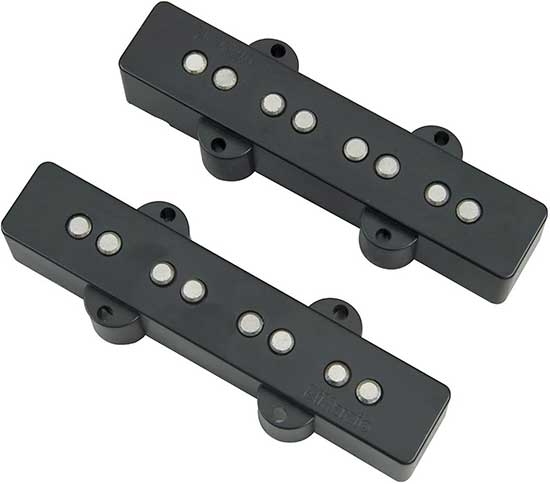
| Estimated Price | $130 |
| Type | Passive hum-canceling split single-coil J-Bass pickups |
| Magnet Type | Ceramic |
| Number of Strings | 4 |
| Pickup Covers | Black or cream |
My Review: DiMarzio’s Model J is one of the most popular J-style pickups on the market, and for good reason. It offers great performance at an affordable price. This pickup is a split single-coil and as a result, is completely noise-free. The range of its sounds includes the J-bass tone, but with more gain and definition to the low end, with a punchy midrange and subdued highs. They sound rich and warm and harmonic tones that are not present with stock pickups. The ceramic magnets at their core give you more bite than the traditional J-style pickup, making them cut nicely through any mix.
Key Specs: This set of pickups was designed for original Fender Jazz Basses which have different size pickups in their bridge and neck positions. They are hum-canceling split single-coils with a moderately hot output. They use ceramic magnets and come with black or cream pickup enclosures, also you can choose between three color options for the pole-pieces: black, gold or nickel.
Target Customer: If you own a J-style bass but are sick of the hum, or if you want a little more growl from it, then give the Model J an ear or two. It is perfectly suited for playing punk, funk, or metal.
Bottom Line: The Model J will expand the versatility of your bass adding a wide range of usable sounds, and all this with an affordable price tag. A great option for all rockers out there.
Related Article: The Best Short Scale Bass Guitars on the Market Right Now
12. Lindy Fralin Jazz Bass Pickup Set
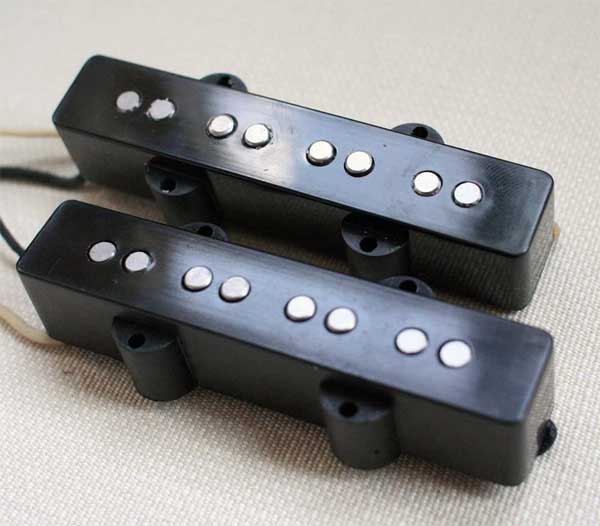
| Estimated Price | $190 |
| Type | Passive Single-coil J-Bass pickup set |
| Magnet Type | Alnico 5 |
| Number of Strings | 4 |
| Pickup Covers | Black, Cream, or White |
My Review: Lindy Fralin is not a well-known pickup manufacturer, but they have steadily built somewhat of a cult following, due to their attention to detail and top-quality pickups. This J-style pickup set is hand-built in the USA to ‘60s era Jazz Bass standards and with period-correct parts. They feature USA-made Alnico 5 magnets and 42-gauge Heavy Formvar coil wire in their hand-wound bobbins, using their proprietary “Sectioning” technique. These pickups have a vintage tone to them, but with higher output and more bite. The sound is well balanced across the frequency spectrum, with tight lows and sparkling highs. The mid-range is loud and fat, cutting through the most crowded of mixes. They’ll work well with anything from blues to hard rock.
Key Specs: The Lindy Fralin Jazz Bass set is all hand-made in the USA, with parts sourced in the USA, in a small shop of only 11 employees. These pickups are built to ‘60s era specifications with Alnico 5 magnets and Heavy Formvar 42-gauge wire. The bridge pickup is compensated for an even volume across all pickups. The bobbins are hand-wound using Lindy Fralin’s “Sectioning” technique. The pickup enclosures come in 3 color variants: black, cream, and white.
Target Customer: This set of pickups is for the Jazz Bass player who demands premium quality components and vintage sound, but with a greater tonal range, clarity, and definition than was available in the time of the original.
Bottom Line: The Lindy Fralin Jazz Bass pickup set comes in at the higher end of the price spectrum, but it is justified considering the great sounds they offer, the high-quality components, and the attention to detail that went into them.
13. Seymour Duncan SMB-4A MM Pickup
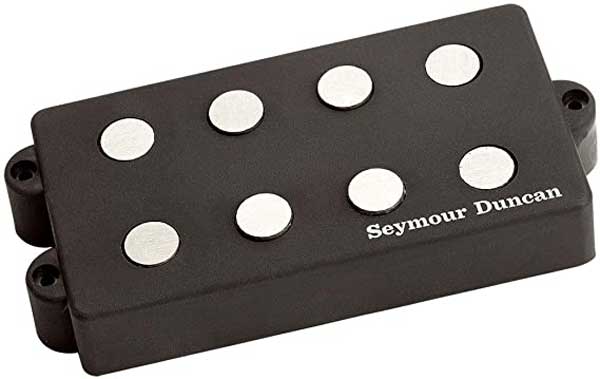
| Estimated Price | $100 |
| Type | Passive 3-coil MM-style humbucker pickup |
| Magnet Type | Alnico 5 |
| Number of Strings | 4 (also available for 5 string basses) |
| Pickup Covers | Black Humbucker Pickups |
My Review: The Seymour Duncan SMB-4A is a drop-in replacement pickup for MM-style basses. It is voiced to reproduce the character and warmth of the 1970s era Music Man Stingray basses, using a unique coil winding technique. It is a 3-coil humbucker design that features oversized Alnico 5 rod magnets with exposed pole-pieces to produce an extended frequency response both at the bass- and at the treble-end of the sound spectrum. The SMB-4A delivers strong clear lows, a precise and snappy high-end without sounding harsh or tinny. It has a vintage tone that is percussive and warm.
Key Specs: The SMB-4A MM-style humbucker from Seymour Duncan is hand-built in Santa-Barbara, CA. It uses oversized Alnico 5 rod magnets with exposed pole-pieces at the center of its three coils and is wound using a unique coil-winding technique. The pickup is vacuum wax potted to eliminate feedback and microphonics. It comes in a black pickup enclosure.
Target Customer: This pickup is for the MM-style bass owner who wants more from his instrument. The extended frequency range and warm punchy sounds make this an ideal MM replacement pickup.
Bottom Line: This is a great pickup, with good build quality and a wide range of MM-style tones. A very affordable way to get much more out of your MM-style bass.
14. Dimarzio DP120 Model One
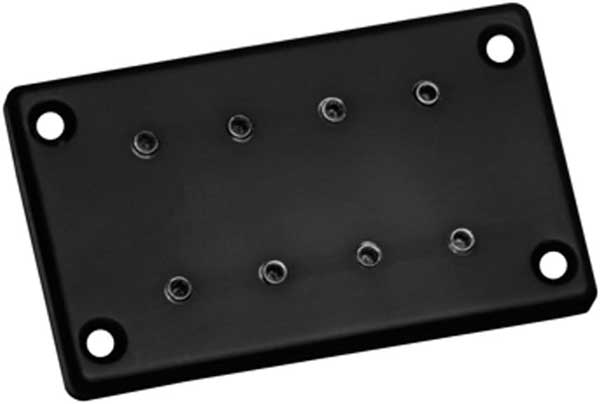
| Estimated Price | $125 |
| Type | Passive Humbucking pickup |
| Magnet Type | Ceramic |
| Number of Strings | 4 |
| Pickup Covers | Black |
My Review: The Model One was originally designed as a replacement pickup for Gibson EB series neck pickups, but they have found their way to a broader audience thanks in part to Billy Sheehan and his booming bass sounds that are his trademark. The DP120 humbucker mixes parts of Dimarzio’s Model J and Model P pickups, this means you’ll get a combination of J-style and P-style tones in a single humbucking pickup. This is a high output pickup made with powerful ceramic magnets and delivers ground-shaking lows, powerful punchy mids, and crystal-clear highs.
Key Specs: The DP 120 Model One is a high output, dual-coil humbucker featuring powerful ceramic magnets and exposed pole-pieces. You get your choice of black, gold, or nickel pole-pieces.
Target Customer: If you have a Gibson EB series bass and want to improve its tone and output or if you like experimenting with unconventional pickup combinations, then the DP 120 from DiMarzio could be the pickup for you. It’s ideal for hard rock and metal bass players.
Bottom Line: This is a powerful and versatile pickup for bass players looking for big bass sounds at an affordable price. While this is one of the more expensive products on this list, some of the best bass pickups on the market and well worth their price tag.
15. Seymour Duncan ASB-BO Blackout Set
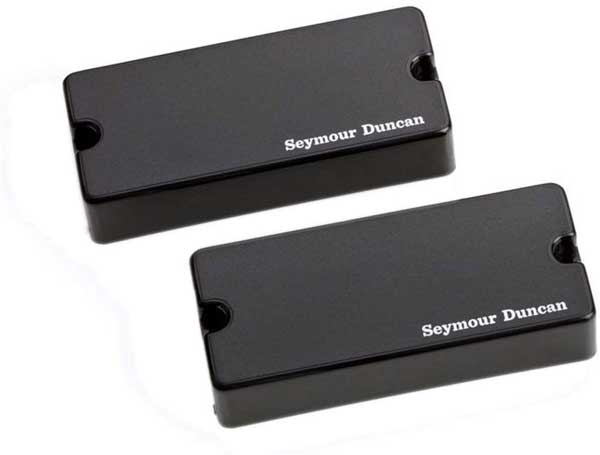
| Estimated Price | $220 |
| Type | Active Humbucking Soapbar pickup set |
| Magnet Type | Ceramic |
| Number of Strings | 4 (also available in a 5 string configuration) |
| Pickup Covers | Black |
My Review: This is Seymour Duncan’s best-selling active soapbar humbucker, designed as a drop-in replacement for EMG 35 sized soapbar pickups. They have a huge dynamic range, voiced for an aggressive tone. Bass sounds with thunderous lows, brilliant highs and percussive mids are its staple. It offers good sustain and an almost overdriven mid-range growl. The ASB-BO’s are very responsive to your playing style, be it with a pick or your fingers, they will register all nuances and dynamics of your playing. Their tonal range makes them perform best on the harder end of the musical genre spectrum, from metal to hardcore.
Key Specs: The ASB-BO is an active dual-coil humbucker with ceramic magnets and a dual-rail design in a soapbar form factor. They come in a black pickup enclosure.
Target Customer: These pickups were created with an aggressive bass tone in mind. A big improvement over the stock soapbar pickups found in most entry-level basses
Bottom Line: The ASB-BO Blackout set is a great option for any metal bass player. They are fairly priced and have a wide range of heavy tones on offer.
16. EMG DE David Ellefson Signature Pickup Set
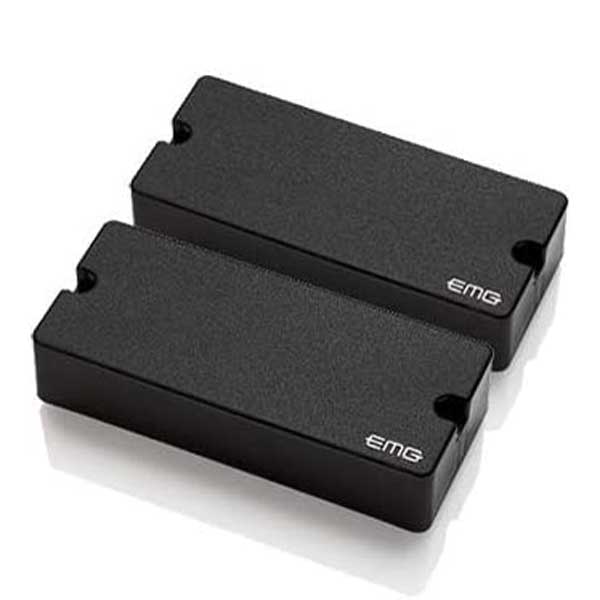
| Estimated Price | $200 |
| Type | Active Humbucker Soapbar pickups |
| Magnet Type | Dual-coil humbucker (Bridge), Ceramic/Steel (neck) |
| Number of Strings | 4 (available in 5 string configuration) |
| Pickup Covers | Black |
My Review: The EMG DE is David Ellefson’s signature pickup set (he’s Megadeth’s bass player). This pickup set uses a dual-coil humbucking bridge pickup, paired with a Ceramic/Steel humbucker pickup in the bridge position. These active humbuckers were created to deliver the purest metal bass sounds. The EMG DE delivers loud, punchy metal bass sounds with a very fast attack. This is a bass- and treble-heavy pickup set, with a slightly subdued midrange, and lots of headroom, that will make your basslines really be heard.
Key Specs: The EMG DE signature set features a pair of active humbuckers in a black soapbar pickup enclosure: dual-coil humbucker in the bridge position, and a ceramic/steel humbucker in the neck position. They also come with EMG’s solderless install system, making installation a breeze.
Target Customer: These pickups are geared towards the demanding metal bass player. They are a great choice if you want to upgrade the stock soapbars in your bass.
Bottom Line: The EMG DE signature set is a great option for metal bass players who want more low-end, more high-end, more presence, just more from their bass tone. As a plus, they are very competitively priced for a set of active soapbars.
17. EMG 35 HZ Pickup
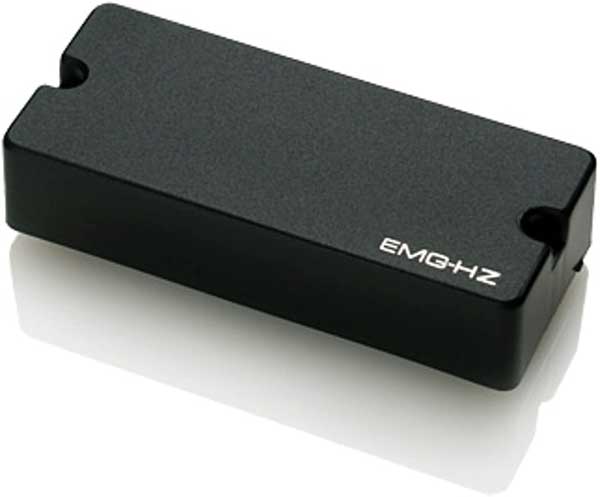
| Estimated Price | $100 |
| Type | Passive Dual-coil humbucking pickup |
| Magnet Type | Ceramic/steel bar magnets |
| Number of Strings | 4 (available in 5 string configuration) |
| Pickup Covers | Black |
My Review: The 35HZ is EMG’s passive dual-coil humbucking soapbar pickup. They use ceramic/steel bar magnets to produce their high output and powerful sound, defined by smooth attack and warmer tone in comparison with other pickups in EMG’s lineup. The use of bar magnets that run through the length of the pickup, makes the 35HZ indifferent to the string spacing on your bass. The tone is bass- and mid-heavy with less high-end sparkle.
Key Specs: The 35HZ features a passive, high output, dual-coil humbucking design with a combination of ceramic and steel bar magnets at its core. They come in a soapbar form factor with a black pickup enclosure and are equipped with EMG’s solderless install system.
Target Customer: The primary setting of the EMG 35HZ, is rock and heavy metal. If you’re looking for the best possible metal sound on your bass, this is one of the best passive options around.
Bottom Line: This is a powerful passive, humbucking pickup, with great tones and an affordable price-tag.
Choosing the Right Bass Guitar Pickup (Buying Guide)
There are two basic pickup types used in most basses: Magnetic pickups and Piezoelectric pickups.
Optical pickups are a relatively recent type of pickup available, they are much less widespread than the main two kinds, but we’ll get to that later on.
What is a Magnetic Pickup?
Magnetic pickups represent the bulk of the pickup market and are by far the most widely used in electric basses or any electric instruments for that matter. They remain mostly unchanged since their inception in the mid-1920s, with only relatively minor tweaks to the original concept. Due to their design, magnetic pickups are required to be positioned right under the strings of the instrument.
In a magnetic pickup, copper wire is wound around a magnet (this is called a coil), when the string (containing iron or nickel) above the magnet vibrates, it will disturb the magnets’ magnetic field and induce an electric current in the copper wire. This electric current is then routed to the output jack of your instrument and will pass through the cable to the amp, where it will be amplified, and you get to hear your bass sing.
Some magnetic pickups are “hotter” than others; this means that they have a higher output voltage, resulting in higher gain and volume. A “hotter” pickup will generally sound fuller and warmer than a lower output one. The downside to a “hot” pickup is less high-end clarity.
The output of the pickup is measured in millivolts and is dependent upon a few variables:
Magnet strength: a more powerful magnet will have a larger magnetic field resulting in higher output voltage
Copper wire gauge and windings: the thicker the copper wire wrapped around the magnet, the higher the output voltage, but as the volume of the pickup enclosure is limited, with thicker wire, you get fewer windings than with a thinner wire gauge. By adding more wraps to the coil, you can increase the output voltage of the pickup. This is why manufacturers sometimes offer “overwound” pickups in their lineup. For optimal pickup output and performance, the pickup maker has to strike a balance between the thickness of the copper wire and the number of coil windings.
String gauge and composition: The most widely used ferromagnetic metals for bass strings – metals that are attracted to magnets – are iron and nickel, iron being by far the most prevalent. Nickel strings have a slightly weaker interaction with the magnetic field of the pickup producing a “mellower” tone.
Heavier gauge strings have more mass to them (more iron or nickel in their composition) so that they will have a stronger interaction with the magnetic field of the pickups, the result is also a higher output voltage.
Another thing to consider with the output voltage is that besides being dependent on the construction of the pickup and the type of strings you use, it is also influenced by how hard you pluck the string. A harder pluck will result in the bass string vibrating with larger amplitude, perturbing the magnetic field more than a lighter pluck would, as a consequence, the output voltage increases.
After all this talk of output voltage, you may think it is the be-all-end-all when choosing a pickup, but as I mentioned earlier, there’s a catch. While you increase the output voltage, you get more volume and gain, driving your amp harder and getting a more pronounced bass and midrange, but you will also steadily lose top-end up-to a point. So if hi-fi or “piano-string-like” bass sounds are your thing, maybe going for the hottest pickup you can find will not do the trick for you.
Types of Magnetic Bass Pickups
Most magnetic pickups you’ll encounter in your search will come in 3 standard flavors: “split-coil” pickups, made famous by the Fender Precision Bass, “single-coils” featured on the Fender Jazz Bass, and “humbuckers” or “dual-coils” the likes of which you’ll encounter on MusicMan Basses.
P-style Pickups
The first magnetic pickup ever made for a production model bass was a single-coil pickup on the 1951 Precision Bass made by Fender. It had the basic single-coil design that endures to this day: four magnets ( one for each string) with exposed pole-pieces wrapped in a copper-wire coil. Fender later switched the single-coil with the now legendary “split-coil” P-bass pickup.
The P-style pickup featured a few improvements over the original. As the name suggests, they took a standard single-coil pickup and split it into two halves, basically creating two pickups that they wired together, performing as a single unit. They also beefed up the pickup in the process, adding more coil wraps and increasing the size of the pickup. This alteration resulted in a pickup with significantly higher output and reduced noise, as single-coils were quite prone to pick up noise from electromagnetic sources such as amps, radios, stage lights, and so on. The P-style pickup was the first humbucking pickup, although its two single-coil halves were offset: half of the pickup was used for the E and A strings, with the other half for the D and G strings. The result was a bass guitar with a buttery smooth low-end and a lot of midrange growl, which defined the early rock ‘n roll bass sound. The only drawback of the P-style pickup was its lack of high-end sparkle, which Fender addressed later on with the Jazz Bass and its classic two single-coil layout.
The P-style form-factor remains mostly unchanged, but there are some variations to the tried and tested design. In addition to the standard split-coil with exposed pole-pieces, you’ll also encounter fully enclosed P-style pickups. This design is less inclined to degrade over time as the coils are coated in resin. There are also “true” humbuckers in P-style format, with 2 separate coils in each half of the pickup like with the Dimarzio DP127.
Another thing to consider is that there are variations in the physical dimensions of the pickups coming from different manufacturers: the P-style pickup in an Ibanez bass is narrower than the standard Precision pickup, so the replacement pickup will not fit inside the pickup cutout of your bass. This issue will probably have to be addressed by a luthier, adding to the cost of the pickup switch. To avoid the luthier you could do it yourself (NOT RECOMENDED) or just check the dimensions of the pickups before buying!
J-style Pickups
In 1960 Fender released the Jazz Bass as the “premium” model in their lineup. It borrowed a lot of design elements from the Jazzmaster guitar. It featured two single-coil pickups (very similar to the original 1951 P-Bass pickup) each unit sporting two exposed pole pieces for every string, but again beefed up for higher output, one positioned close to the bridge, and the second one placed towards the neck with separate volume controls for each pickup, letting you dial-in the desired balance of the two. The neck pickup is defined by a thick and airy tone while the bridge pickup sounds tight and punchy. They still picked up a lot of hum when the volumes were not set to the same levels. Single-coils are usually long and slender, each unit covering all four strings on the bass guitar, and are often described as sounding clear and bright in comparison with split-coil pickups. As the name suggests, this pickup style is preferred by jazz bassists but is not limited to that style of music (there are a lot of metal and rock bass players using Fender Jazz Basses or J-style pickups in their instruments of choice).
The J-style single-coils also come in the resin-coated, fully enclosed variety without the exposed pole pieces, eliminating the issues regarding humidity leading to the corrosion of the coils that will degrade the pickup and alter its tone, as a consequence.
Noise-canceling single coils
As stated above, single-coil pickups pick up hum or electromagnetic interference from your environment, be it from fluorescent lighting sources, tube amps, radios, or computer monitors. To address this issue, manufacturers created the noiseless single-coil pickup. These are not single-coils in the true sense, as they are more closely related to “humbuckers” having two coils per pickup. But while in a true humbucking pickup the coils are positioned side-by-side, with the noiseless variety the two single coils are stacked on top of each other and have different windings or copper wire gauges, separated by a metal plate. They are in essence humbuckers because they buck the hum, but from a tonal standpoint, they sit somewhere between humbuckers and single-coils. Purists and fans of the single-coils sound still prefer true single-coils as they are brighter and punchier.
Their name also creates some confusion because they are single-coils only regarding their form factor.
Humbuckers
Humbucking pickups for bass guitars were introduced to “buck the hum” of the classic single-coils of the 60’s jazz basses. They were initially designed in the Gibson guitar factory by wiring two single-coils together, side-by-side, and out of phase with each other. This cancels out the electromagnetic interference single-coil pickups are known for while producing a harmonically rich sound with lots of low end. Because they are in essence two glued-together single-coils, they have a much higher output and as a result, are louder and have more gain than any other type of magnetic pickup. When compared to the P-style pickup (with which they are more closely related sonically), they have a tighter low end and an even more pronounced midrange. This is why Music Man basses are so well represented in the rock scene. As with the P-style pickup (also a humbucker), the highs are attenuated because of the basic design of the pickup.
Active pickups
Active pickups are a variety of magnetic pickup that features a powered preamp in its design. The preamp usually runs on a 9V block battery (sometimes two) and is used to drive your signal consistently through to your amp and anything along the way. This is not the same as an active preamp circuit in your bass that lets you EQ your sound before the signal leaves your bass. Though you will find them most often paired with an active preamp. Active pickups just boost your signal for more consistency but at the cost of removing some of the dynamics in your playing. This can be useful if you play music genres where your volume stays more or less at the same level as with metal or punk.
Piezo pickups
In contrast to a magnetic pickup that senses the changes in the magnetic field while the strings vibrate above it, a Piezo pickup senses the changes in pressure of the instrument itself and converts this vibration into an electrical signal, making it the main type of pickup when amplifying acoustic instruments. Since piezo pickups don’t rely on magnets, they can be used with non-ferromagnetic strings, such as nylon strings. Usually, piezo pickups are either placed directly under the bridge of the instrument or, in the case of electric bass guitars, inside of the bridge, each string has its own pickup. A piezo pickup is very bright sounding and has a much faster attack when compared to magnetic pickups. Bass players have found that pairing the fast attack and brightness of a piezo with the low end and midrange of a magnetic pickup produces sonically pleasing results and greatly improves the versatility of the instrument. A piezo pickup on bass needs the right active preamp to avoid sounding brittle and thin and also to dial in the desired mix between the magnetic pickup and piezo.
Optical pickups
Optical pickups have been around for almost 50 years but their use as bass pickups has not been popular. Only in recent years have professionals started to consider them as alternatives or complements to magnetic pickups. Optical pickups use light to detect the string vibrations. A LED is pointed at each string and a light-sensitive detector measures the refracted light as the string vibrates and converts the measured vibrations into an electrical current sending it down your signal path to be amplified. This makes them very accurate and leads to some major improvements when compared to magnetic pickups:
Optical pickups are immune to outside interference and don’t produce any hum or noise. They have a broader frequency range at any volume level with a completely flat response curve as there is nothing but light being refracted off of the string. An optical pickup will also have increased sustain when directly compared to a magnetic pickup, as magnetic pickups slightly pull on the string due to their magnetic field, reducing sustain. The design of the optical pickup makes it very good when a clean signal is desired but they are not as good with effects such as distortion. Many bass players still prefer the dirtier sound of a traditional magnetic pickup over the optical kind, due to its perceived lack of character and the slight drawback when using effects.
Other pickup terminology
Soapbar pickups: This term only describes the enclosure for the pickup (they look like black soap bars), and they are usually humbuckers although this form factor is sometimes used for “noiseless single-coils” (still technically a humbucker pickup) or single-coils.
Rail pickups: This is a humbucker type pickup that uses two rails instead of individual magnets for each string, and they look like rail tracks. The advantage of rail pickups is that they are not influenced by string spacing as traditional magnetic pickups are. They are defined by very high output and consistent dynamics from string to string. Sonically they adhere to the humbucker sound: lots of low end and a well-defined midrange with less high-end content.
MM Pickups: This term refers to the oversized humbucker pickup found on the Music Man Stingray basses.

My name is Chris and I’ve had a passion for music and guitars for as long as I can remember. I started this website with some of my friends who are musicians, music teachers, gear heads, and music enthusiasts so we could provide high-quality guitar and music-related content.
I’ve been playing guitar since I was 13 years old and am an avid collector. Amps, pedals, guitars, bass, drums, microphones, studio, and recording gear, I love it all.
I was born and raised in Western Pennsylvania. My background is in Electrical Engineering, earning a Bachelor’s degree from Youngstown State University. With my engineering experience, I’ve developed as a designer of guitar amplifiers and effects. A true passion of mine, I’ve designed, built, and repaired a wide range of guitar amps and electronics. Here at the Guitar Lobby, our aim is to share our passion for Music and gear with the rest of the music community.

Good stuff Chris!
Well done and thanks!